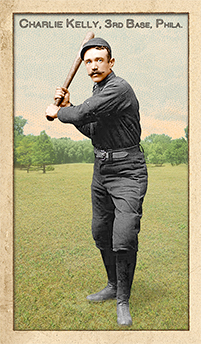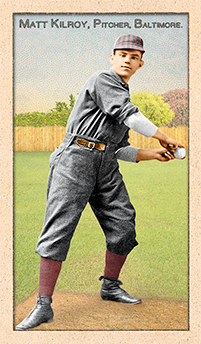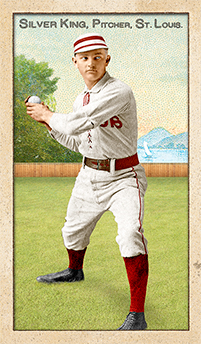- Series: Beginnings: 1880's
- City: New York
- Team: Giants
- League: National League
- Hall: National Baseball Hall of Fame
Smiling Tim, Sir Timothy (1857-1933). A dominant pitcher for 5 teams over 14 seasons, Keefe’s 1st season was the last in which pitchers threw from 45′ & his last season was the 1st in which they threw from 60’6″. In an extraordinary career, Keefe won 20+ gms 7x; 30+ gms 6x; 40+ gms 2x; 200+ Ks 6x; 300+ Ks 2x; & posted lowest ERA in history: 0.86 in 1880.
- Won Triple Crown: 1888
- ERA Champ: ’80, ’85, ’88
- 342 career Wins
- Elected to Hall of Fame: 1964

- Series: Beginnings: 1880's
- City: Cincinnati
- Team: Red Stockings (AA)
- League: American Association
James William Keenan (1858-1926) had a substantial major league career as a decent hitting catcher, primarily for Cincinnati. He got his start at the dawn of pro ball with his hometown entry in the National Association in 1875, its final season. The New Haven Elm Cities struggled to a 9th place finish but Keenan was on his way. He played minor league ball until the Buffalo Bisons of the NL hired him in 1880. After brief appearances with the Pittsburgh Alleghenys & Indianapolis Hoosiers, Jim caught on as a regular catcher with Cincinnati, 5 years with their AA team and his last two with the NL version, the Reds. A lifetime .240 average testifies to his skills at the plate in a rugged era for catchers. He played other positions and even gets his name in the record books: per the Encyclopedia of Baseball Catchers he is one of 41 receivers to pitch in major league games and his 2.37 ERA places him first all-time among his cohorts (he hurled 19 innings and was 0-1).
- As an emergency replacement at catcher for New Haven, Jim witnessed teammate Billy Geer make seven errors in one inning at second base
- Series: Beginnings: 1880's
- City: Philadelphia
- Team: Quakers
- League: National League
Charles H. Kelly (18??-????). Perhaps the most obscure player in this set, Charlie was a third baseman who made two brief major league appearances: he played in 2 games for the Philadelphia Quakers in 1883 and 1 game for the Philadelphia Athletics in 1886.
For his career, Kelly made one hit in 10 at bats. It was a triple and he did score a run. Perhaps his undoing was his defense, as he made 7 errors in 16 chances.

- Series: Beginnings: 1880's
- City: Boston
- Team: Beaneaters
- League: National League
- Hall: National Baseball Hall of Fame
Michael Kelly (1857-1894) was one of the great stars of the 1880s. He inspired America’s first pop record (“Slide, Kelly, Slide!”) in 1889 with a 1927 movie to follow. The “Chicago Slide” was copied by his White Stockings teammates, a “combination slide, twist and dodge” that allowed the team to “get away with hundreds of stolen bases when really they should have been touched out easily” per the Tribune’s Hugh Fullerton in 1906. A catcher, right-fielder and manager over 16 years, he popularized the hit & run.
- A pioneer athlete in vaudeville, $10,000 Kelly also popularized autograph signing
- First major leaguer to publish his autobiography (1888)
- Elected to Hall of Fame: 1945
- Although the Old Judge series features eleven known poses of Mike Kelly, I could not find one of suitable quality for this project. This image is taken from a cabinet photo produced by the Hastings Studio in Boston.

- Series: Beginnings: 1880's
- City: Louisville
- Team: Colonels
- League: American Association
John O. Kelly (1856-1926) was known variously as Kick, Honest John and Diamond John. He was a catcher for the Syracuse Stars and Troy Trojans in 1879 before turning to his real calling of refereeing, first in baseball and later in the boxing ring. As an operator of gambling houses in his native New York City, John “officiated” at another kind of gaming later in life.
Kick’s record at bat was a perfect motive to change uniforms. He averaged .155 in his 16 games in the early major leagues. By 1882 Kelly was umpiring in the National League and moved to the American Association the following season. Men in blue fared poorly in the diamond’s dawn. They were vilified and, too often, pelted by players and fans alike. Working alone gave ample opportunity for wily runners to cheat. Kelly lasted longer than most of his era. He and another “Honest John” (Gaffney) presided over the 1887 post-season match between the NL’s Wolverines and AA’s Browns. They pioneered a two-ump system that would transform the game.
- Kelly turned briefly to managing with the Louisville Colonels in 1887 and had a successful 76-60 season. His club flagged the following year and Kick was canned
- Refereeing Jim Corbett’s match in 1894 nearly cost Kelly his life. Baseball wasn’t the only hazardous profession for officials. Well-armed fans intimidated Kelly into a no-call
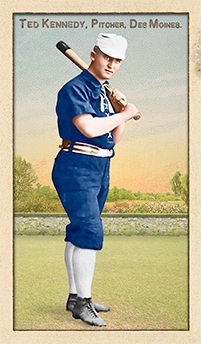
- Series: Beginnings: 1880's
- City: Des Moines
- Team: Prohibitionists
- League: Western Association
Theodore A. Kennedy (1865-1907) was an ill-starred young pitcher who learned from the best, executed effectively and, as so many of his era, flamed out early with a ruined shoulder. In our day, with Tommy John surgery nearly a rite of passage for aspiring big-leaguers, it is sobering to consider the plight of the young men of the 19th century who were thrown into unrelenting action and treated as disposable cogs in professional baseball's juggernaut. Such was the lot of Ted Kennedy. As a youth, he was ball boy in Peoria studying the not-yet-Old-Hoss Charlie Radbourn, the star pitcher for the town's very fine amateur squad. Radbourn was said to have been the first to master the overhand curve delivery that would carry him to greatness with Providence years later. Radbourn showed Ted the grip and Ted worked hard to learn it. He emerged in mid-west circles as one of the most promising young pitchers in 1884, a year of turmoil in the major leagues that left minor league teams scrambling for talent. The next season Kennedy got his break when Cap Anson brought him to Chicago. The Chicago Tribune's June 12 edition reported: “The Chicago team will place a new man in the pitcher's box today—Ned Kennedy, until recently with the Keokuk nine, and looked upon as one of the strongest unengaged pitchers in the country.” Ted's astounding strikeout record had made that reputation. Before the call-up, his highlight was 24 Ks, including 17 straight, in a game with no putouts by the first baseman against Burlington in October of '84. Sadly, Ted's arm didn't survive his rookie year. After hurling three games in two days, his shoulder gave out. Though he pitched one more year in the majors and a few in the minors, he was never the same. Kennedy later remembered, "I was terribly lame - had to pitch underhand. Every game I pitched that season it was like a rusty knife was being thrust into my shoulder."
- In retirement, Kennedy found a lucrative career in sporting goods, eventually selling out to the Spalding empire but continuing to teach youngsters how to throw the curve
- Ars Longa is indebted to the research of SABR's Craig Lammers for much of this bio
- Kennedy's uniform color on this card was changed in July, 2017 from black to blue to reflect recent reliable research by Craig Brown & friends at Threads of Our Game. One card was previously released featuring a black uniform.
- Series: Beginnings: 1880's
- City: Baltimore
- Team: Orioles
- League: American Association
Matthew Aloysius Kilroy (1866-1940). Kilroy pitched for 6 teams over 10 seasons; most famously for the Baltimore Orioles. Did you know that Matt Kilroy is the single season record holder with 513 Ks in 1886? That’s 72 Ks more than the next closest total. Kilroy’s 1st 2 years: 75-53, 137 GS, 132 CG, 730 Ks & 3.22 ERA. After his sophomore year, Kilroy would win 20+ games once more, but then descended into mediocrity – going 20-34 over the last 6 years of his career.
- Pitched a no-hitter: 10.6.86
- Series: Beginnings: 1880's
- City: St. Louis
- Team: Browns (AA)
- League: American Association
Charles Frederick Koenig (1863-1927). An excellent pitcher for 7 teams over 10 seasons, King was one of the 1st pitchers to use a sidearm delivery and was especially unique in that he threw without winding up. In his career, King won 203 games, striking out 1,229 batters with a 3.18 ERA. Currently, King ranks 93rd in career WAR for pitchers, higher than 15 HOF pitchers. Silver was pretty good.
- AA Wins champ: 1888
- AA ERA Chap: 1888
- PL ERA Champ: 1890
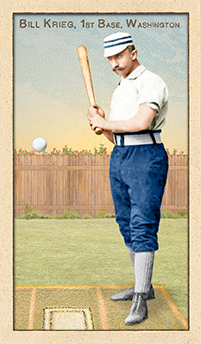
- Series: Beginnings: 1880's
- City: Washington, D.C.
- Team: Nationals
- League: National League
William Frederick Krieg (1859-1930) was a powerhouse in the minors, but barely left an impression in the big leagues. Coming out of Notre Dame, Krieg joined the Northwestern League's Springfield and Peoria teams in 1883. The following season he got a chance at the big time as the Union Association multiplied opportunities for young pro players. He signed on with the bi-city Chicago/Pittsburgh entry as their catcher, playing in 71 games with a .247 average. Over the next three seasons, Bill would roam among three other major league clubs and various minor league teams. His stints in the American Association and National League were brief and his output paltry.
When he finally resigned himself to play in the minors permanently, Krieg came into his own. In 1887 with the Minneapolis Millers he batted .402, second in the Northwestern League. He then became a terror in the Western Association, hitting .324 with St. Joseph in '89 and .339 with Milwaukee in ‘92, good for his first batting title. His second title was historically good, when he ravaged WA pitchers for an astounding .452 performance with the Rockford Forest Citys in 1895. He was the team's slugger, tallying 15 triples and 12 home runs.
While Krieg's time in the majors was brief, he showed remarkable durability in the game. He finally retired as a player in 1901 at age 42, but served one more season as manager for the Southern League Chattanooga squad. Bill even returned for one last hurrah as manager of Muscatine of the Central Association in 1912.
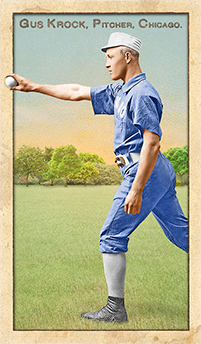
- Series: Beginnings: 1880's
- City: Chicago
- Team: White Stockings
- League: National League
August H. Krock (1866-1905) first pitched in the majors for Cap Anson’s Chicago White Stockings in 1888. He had a spectacular rookie season going 25-14 with a 2.44 ERA. Typical of his day, Gus finished what he started. He completed all 39 appearances with four shut-outs. Unfortunately, he struggled thereafter, never winning more than three games in a year. He came back with Chicago in ’89, then bounced to the Hoosiers, Senators and Bisons, exiting MLB after the 1890 season. As he helped Anson’s crew to a second-place finish in ’88, Gus had a face-off with a 40-year-old rookie for Washington, John Greenig. It would be a rare day for a rookie to make his big league debut at such an age and the press took note of the May 9 start. The White Stockings dispatched the hapless Greenig with nine quick runs and Krock was complimented for his steady performance, a five-hitter with Dummy Hoy doing the only damage with a homer and single.
- Before and after his years in the bigs, Gus played for Oshkosh, Milwaukee, and Sioux City in the Northwestern League and Western Association
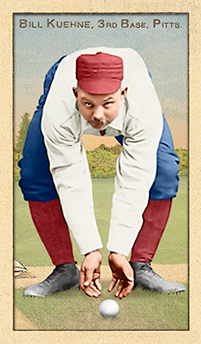
- Series: Beginnings: 1880's
- City: Pittsburgh
- Team: Alleghenys
- League: National League
William J. Kuehne (1858-1921) came out of the German-American semi-pro clubs of Chicago to begin his career in truly professional baseball with the Columbus Buckeyes of the American Association in 1883. After a month of dreadful play at 2nd base, his manager replaced him. Having a hole at 3rd, he gave Willie one more try. Kuehne found a home at the hot corner. What followed was a ten-year career in MLB in which the otherwise light-hitting but solidly-built (and not known for speed) Kuehne played as though every day was “triple or nothing.” His lifetime .232 average belied a penchant for three-baggers. His record for “most triples in a season without hitting a home run” (19 in 1885) lasted until another Willie--Keeler--tied it in 1897. SABR’s David Nemec has documented several other odd “firsts” set by Kuehne: “lowest slugging average with at least 100 triples,” four straight seasons with more triples than doubles, and most triples (115) in history by a player with fewer than 4500 plate appearances. One in every nine hits went for three.


